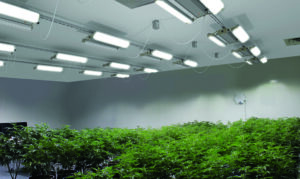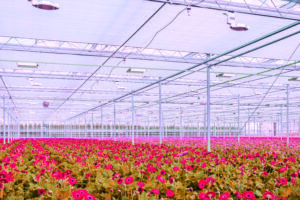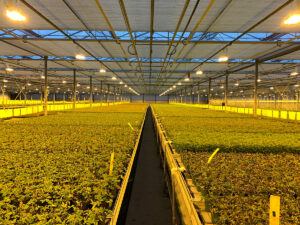Given historically high energy costs and the increasing difficulty of finding replacement parts and lamps for obsolete magnetic ballast luminaires (light fixtures), many growers are looking to upgrade their lighting systems. Doing so can help them reduce electrical consumption and operating costs, increase light intensity, improve crop health and yields, and/or take advantage of energy efficiency rebate programs.
Depending on each grower’s specific needs, a lighting upgrade could mean switching completely from HPS to LED luminaires; upgrading to a hybrid (LED-HPS) lighting system that takes advantage of existing infrastructure—including HPS luminaires—but adds in new LEDs so growers get the best of both worlds; or even retrofitting older magnetic ballast to new electronic ballast HPS light fixtures.
HID to LED RETROFIT
One of the most common retrofits is growers replacing legacy HPS with LED lights. One of the main reasons growers opt for the switch to LEDs, is because LEDs use much less energy to produce the same light levels as HPS fixtures. In addition, LEDs provide more control, as they have a more efficient spectrum for converting photons into usable photosynthetic energy (referred to as photosynthetically active radiation or PAR). LEDs can also be dimmable, and they start up and power down more quickly than HPS luminaires—making it easier to manage and control your environment. Now is a really great time to undertake an LED retrofit—since many states, provinces, and territories offer rebate incentive programs for growers installing LEDs. In many instances the rebates being offered are quite substantial and can cover a large percentage of the new fixture cost. Given these programs are offered for a limited period of time and/or subject to the the availability of allocated funds, growers would be well advised to act sooner than later if they’re considering an LED retrofit to avoid missing out on qualifying for any available rebates.
Choosing the right spectrum
When choosing LED lights for your retrofit, one important consideration is selecting the best spectrum for your needs. Commercial growers typically want a fixed spectrum that is optimized for the greatest flexibility in terms of the type of crops/cultivars that can be grown under the lighting system, so they opt either for a broad “white” spectrum or a red/blue spectrum. For many indoor grows, where they rely on artificial lights as their only source of light to grow plants, broad spectrum “white light” LEDs are the best option. This is because these lights offer the plants a more complete spectrum—similar to natural sunlight. They are also better for the workers because white light creates less of a strain on the eyes than blue/red light, and also makes plant assessment much easier. Broad spectrum “white” LED lights can be used for all stages of growth, including both vegetative and flowering growing stages.
Luminaires that use a combination of red and blue LEDs to create a light spectrum that appears pink or purple, are usually recommended for supplementary lighting in greenhouses, where plants already receive full spectrum sunlight from the outdoors. Since photosynthesis peaks in the blue and red spectrums, photons are more easily converted into photosynthetic energy at these wavelengths and therefore increase the overall energy efficiency of the lights.
Light Output and Uniformity
While an LED and HPS luminaire may emit the same PPFD (the amount of PAR light delivered to a square meter each second), some growers may discover they need to install a greater number of LEDs vs. their HPS fixtures to achieve comparable light uniformity over the crop. This is because HPS lights use special reflectors to widely distribute the light over the crop surface. The resulting crossover of the light helps achieve a layout with fewer luminaires and higher uniformity. Since most older generation of LED luminaires and/or many “budget” LED luminaires do not use any optical devices to control the distribution of the light the way a reflector would, most of the light is directed downwards—meaning you generally require more LED vs. HPS fixtures to achieve the same light uniformity. Addressing this limitation of LED technology was a major focus for the leading horticultural lighting manufacturers over the past couple of years. The industry is now at the point where integrated optical solutions have resulted in the current generation of LED luminaires, delivering light distribution and uniformity at par with that delivered by a high-performance HPS reflector. P.L. Light Systems’ (super) high-powered ParFX Ultra luminaires, for example, feature optical lenses that deliver true batwing distribution for optimal light uniformity. This wide distribution of light, in combination with high light output, enables exceptionally wide row spacing—meaning the desired light levels and uniformity can be achieved with significantly fewer fixtures and in turn, significantly lowering the cost/μmol of light. Another highly innovative LED product, the TriPlane Linear, features independently adjustable LED modules for precise and customizable light distribution.

Installation / Infrastructure Considerations
When retrofitting your legacy lighting system, you also need to pay attention to any potential installation and infrastructure costs. Depending on your building design, you may need to install additional tracks to hang the LED luminaires to ensure uniform light distribution over the crop. A light plan, designed specifically for your application, will consider these things to ensure you have the highest uniformity. In addition, the distance from the bottom of the light fixture to the crop canopy should also be considered when making the switch.
You should always review your electrical infrastructure with your electrical designer before transitioning to an LED lighting system. You will likely find that LEDs draw less power than HIDs, so an existing infrastructure that can support HID should also accommodate LED luminaires. However, if you are currently operating a 400W or other lower-wattage HID system, or transitioning to a super high-power LED lighting system, that infrastructure may not be sufficient to power higher-output LEDs. In this case, an electrical upgrade and/or retrofit may be necessary. As long as you work with a lighting company that provides a professional light plan, you will be aware of any upfront costs or additional electrical work you may need to plan for before moving ahead with a new lighting system.
Radiant vs. Convection Heat
Another important consideration is that the heat generated from HPS lights is often used to help offset heating costs in cold climate regions. In a 2021 study by Wageningen University, they set out to see how much energy is saved with an LED versus an HPS system in a greenhouse application, when considering additional heating costs. They found that LEDs will reduce energy consumption for lighting by around 40%, but will increase heating requirements by 25%, making the total energy savings around 15%. So, the financial benefits of a transition to LEDs will depend on the energy and environmental costs associated with the application. This study helped demonstrate that to understand the true energy savings of LEDs, you must consider the entirety of your operation and include other areas of energy usage that can be affected by a switch in lighting technologies.
HYBRID LED-HPS LIGHTING SYSTEM
For growers who aren’t ready to fully transition to an LED lighting system, a hybrid lighting system may be the ideal solution. This is becoming an increasingly popular way to light CEA crops. By installing an LED-HPS system, growers can keep their existing infrastructure, including some HPS luminaires, and can then replace just a portion the HPS luminaires with LED fixtures on the existing track/truss. Hybrid lighting systems can be used for vine crops, cannabis, leafy greens, and ornamentals in both greenhouse and indoor applications.
A hybrid lighting system is so popular because it allows growers to take advantage of the heat from the HPS luminaires during winter while extending the season into early fall and spring with LEDs. Another key advantage is that by adding LEDs to your HPS system, you will enjoy some energy savings, since the LEDs use less electricity, but produce the same amount (or more) of light. A hybrid installation also allows for a quicker payback period, and growers can still take advantage of the financial rebate programs offered in Canada and the USA.

LEGACY MAGNETIC HID to ELECTRONIC HPS RETROFIT
Well-maintained HID luminaires can last for decades. In fact, P.L. Light Systems has customers who are still running lights they installed 10 – 15 years ago – sometimes even longer than that. However, finding replacement lamps and other parts like capacitors and ignitors is becoming very difficult, if not impossible. That’s because this old, magnetic ballast technology is now considered obsolete, so the component manufacturers are no longer making these parts. So, if this is your scenario, you really can’t put off upgrading your lighting system any longer.
That doesn’t necessarily mean you have to invest in LED technology to reap the benefits of improved lighting technology. HPS luminaires have come a long way in their 40+ years on the market, and there is a reason they remain a very popular type of horticultural lighting. Many growers are accustomed to growing under HPS and are reluctant to change what works for them. Additionally, many crops including tomatoes, cucumbers, flowers, and cannabis grow very well under HPS conditions.
 One of the best parts of newer HPS technologies is they can deliver the same amount of light (or more) with fewer luminaires than older legacy lighting. This is due to their higher wattage, increased light intensity, and improved reflector technology, helping spread light further. Electronic ballasts make it simple for growers to start their horticultural lights. Maintenance and repairs are also much faster and easier. In addition, finding compatible lamps for new double-ended HPS luminaires is very easy and installation is much more straightforward.
One of the best parts of newer HPS technologies is they can deliver the same amount of light (or more) with fewer luminaires than older legacy lighting. This is due to their higher wattage, increased light intensity, and improved reflector technology, helping spread light further. Electronic ballasts make it simple for growers to start their horticultural lights. Maintenance and repairs are also much faster and easier. In addition, finding compatible lamps for new double-ended HPS luminaires is very easy and installation is much more straightforward.
An additional advantage of upgrading to electronic HPS lighting is that you should not require any major changes to your mounting and/or electrical infrastructure. We have worked with many growers over the last few years who have seen huge improvements in their business due to retrofitting with electronic ballast luminaires, including Burnaby Lake Greenhouses and the Houweling’s Group.
A concern over recent years for some growers considering investing in new HPS luminaires, was the proposed Canadian legislation to ban the manufacture and import of HPS horticultural lamps by the end of 2028 and the sale of HPS horticultural lamps by the end of 2031 as part of Canada’s commitment to the Minamata Convention on Mercury. In June 2024, however, the Canadian government lifted the these previously proposed dates for the banning of HID fixtures and lamps used for plant growth. This brought the Canadian legilation in line with the legislation in the USA. Although the USA has also signed this global Minamata treaty and did federally ban all “general service” incandescent lamps (effective August 1st, 2023), they ultimately issued an exemption for lamps that are used for horticultural / plant growth purposes – leaving it to each state to issue their own guidelines. For example, California, known to have the strictest energy-saving measures, issued their Title 24 energy efficiency standards on January 1st, 2023 which include minimum efficacy requirements for greenhouse (PPE ≥ 1.7 μmol/J) & indoor (PPE ≥ 1.9 μmol/J) applications – these are in line with the current high-output, high-quality double-ended HPS lamps. Given the most current legislation still allows for the use of HPS technology in horticultural lighting applications for the foreseeable future, and that we are still able to source ballasts and lamps for our HID products from a number of suppliers, P.L. Light System will also continue to support this technology platform for the foreseeable future.
One of the greatest advantages of working with P.L. Light Systems is that we manufacture both LED and HID technologies and offer complete hybrid solutions. We also locally stock and sell replacement parts and lamps at highly competitive pricing. What this means for the grower is we can help assess all options when maintaining or upgrading their lighting systems. This allows us to provide options that account for the exact goals the grower wants to achieve.
Contact Us
If you are interested in reaching out to us, please contact one of our Regional Sales Managers.


